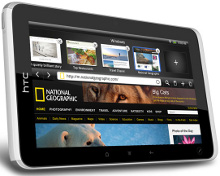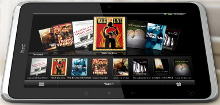HTC’s Flyer tablet features pen interface, Android 2.4
Feb 15, 2011 — by Eric Brown — from the LinuxDevices Archive — 1 viewsHTC announced a seven-inch, 1.5GHz tablet that features pen support and links to online video and gaming services. The HTC Flyer features a new version of HTC's Sense UI layer atop a hybrid version of Android 2.4, and offers 1GB RAM, 32GB of flash, microSD expansion, five-megapixel and 1.3-megapixel cameras, plus HSPA+, 802.11n, GPS, and Bluetooth 3.0.
The HTC Flyer was announced at Mobile World Congress (MWC) along with updated versions of HTC's Wildfire, Incredible and Desire smartphones, as well as new Facebook-oriented HTC ChaCha and Salsa smartphones, according to separate stories posted from Barcelona by Nathan Eddy on our sister site eWEEK.

The HTC Flyer with stylus and "Scribe" pen technology
(Click to enlarge)
Interestingly, the Flyer is not a nine- or 10-inch Android 3.0 ("Honeycomb") model running a dual-core Nvidia Tegra 2 processor — the standard template for most of the announced Honeycomb tablets (including the Motorola Xoom, Toshiba Tablet, and this week's Samsung Galaxy Tab 10.1). Instead, the device flies with a seven-inch format and runs Android 2.4 on an unnamed 1.5GHz processor, according to the company.
The Flyer is one of the first products to publicly claim the upcoming Android 2.4 release for its own. Confusingly labeled "Gingerbread" along with the existing Gingerbread (Android 2.3), Android 2.4 is rumored to add dual-core support when it is expected to be released in April or May. It does not, however, appear to be inherently optimized for tablets, as is Android 3.0.

HTC Flyer showing new tablet-focused Sense UI
(Click to enlarge)
Perhaps to compensate for its lack of Honeycomb, HTC has added a pen interface to the Flyer's seven-inch, 1024 x 600 capacitive touchscreen, as well as a special capacitive stylus designed to work with "Scribe" pen technology. The Scribe technology provides "digital ink innovations" that HTC says makes it easier to take notes, sign contracts, draw pictures, or write on a web page or photo.
A related "Timemark" feature enables users to capture the audio of an event in line with written notes, so tapping on a word in the notes instantly takes users to the exact place in time in the audio recording of the meeting. Notes are also integrated with the calendar, so when there is an appointment reminder, users are prompted with an opportunity to begin a new note or, in the case of recurring meetings, to continue where the last meeting left off. The Flyer also features built-in synchronization with Evernote, a notes application and service, says HTC.


Web browsing on the Flyer (left) and HTC Watch video interface
(Click on either to enlarge)
The Flyer sports both a five-megapixel auto focus camera and a front-facing 1.3-megapixel videocam capable of 720p video capture. Other features are said to include a micro-USB 2.0 port, a 3.5mm audio jack, SRS virtual surround sound, an ambient light sensor, a digital compass, and a G-sensor. There does not appear to be an HDMI port, however.
The 7.7 x 4.8 x 0.52-inch (195.4 x 122 x 13.2mm) tablet weighs 14.8 ounces (420 g), says HTC. The 4000mAh battery is said to play up to four hours of video, and last 870 to 1,470 hours on standby.
Sense for tablets, plus HTC Watch video service
The Flyer's new tablet-focused Sense platform features a 3D home screen with a Honeycomb-like carousel of widgets. The tablet also offers web browsing with Flash 10 and HTML 5, says the company.
HTC also announced HTC Watch, a connected video service that will debut on the Flyer tablet. The Watch service provides on-demand progressive downloading of HD movies, offering playback over the tablet's broadband wireless connection.
Despite the focus on note-taking in the formal announcement, HTC's Flyer site touts the tablet primarily for its game-playing capabilities. Indeed, the tablet will also integrate HTC Watch with OnLive Inc.'s cloud-based gaming service. When integrated fully, the OnLive service will enable customers to pipe the OnLive service through the Flyer to a digital TV via Wi-Fi, or let users play games directly on the tablet.
A number of MWC observers were disappointed with the Flyer, including Phandroid's Rob Jackson, who "wasn't impressed" with the tablet during a demo captured on YouTube (see below). After sampling Honeycomb tablets such as the Xoom, the LG Optimus Pad, and the Samsung Galaxy Tab 10.1, Jackson writes that the Flyer suffered in comparison.
As usual with HTC, the hardware seemed to be solid, but the software was "noticeably laggy, slow and just didn't feel right," writes Jackson.
HTC Flyer demo on YouTube
Source: Phandroid
(Click to play)
Availability
Due to ship in the second quarter, the HTC Flyer tablet will be the first of several Flyer-branded Android tablets to arrive from HTC this year, according to a "tip" report last month from DigiTimes. The story said the next two tablets will offer Android 3.0.
More information may be found on HTC's Flyer page.
This article was originally published on LinuxDevices.com and has been donated to the open source community by QuinStreet Inc. Please visit LinuxToday.com for up-to-date news and articles about Linux and open source.